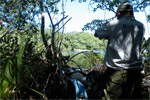
Pronghorn females with male in background in Montana. Photo by: Jeremy Hance.
Development of natural gas fields in Greater Yellowstone Ecosystem is pushing pronghorn (Antilocapra americana) out of crucial wintering grounds, a situation that could result in a population decline according to a new study in Biological Conservation. By tracking 125 female pronghorn over five years in Wyoming, researchers found that highest quality habitat had fallen by over 80 percent in two vast gas fields on land owned by the government’s Bureau of Land Management (BLM).
“In our study we have detected behavioral shifts for pronghorn in response to natural gas field development and infrastructure on federal BLM lands,” explains lead author Jon Beckmann with Wildlife Conservation Society’s North America Program in a press release. “By detecting behavioral changes, it is possible to identify threshold levels of gas field infrastructure development before any significant population declines. Maintaining the integrity of crucial wintering areas is particularly important in harsh winters to avoid diminishing pronghorn numbers.”
Since pronghorn are hunted in the area—keeping numbers below the ecosystem’s carrying capacity—researchers expected that habitat loss would have little impact on the pronghorn. Instead they found clear behavioral shifts due to the expanding natural gas infrastructure in the BLM’s Pinedale
Anticline Project Area (PAPA) and Jonah Fields, which together cover over 90,000 hectares.
“Behavioral responses by species to habitat loss may be a precursor to population impacts, such as lower reproduction and survival rates,” the researchers write.
The Wildlife Conservation Society (WCS) recommends that the government require pronghorn baseline population data before any development is allowed on BLM land, and population and habitat monitored after such development. In addition, the group says directional drilling would help habitat.
“Ultimately this is a policy issue for petroleum extraction on U.S. public lands. In several cases science indicates that petroleum developments have had negative impacts on wildlife. We are hopeful that studies like these will inform future energy development on public lands in the West,” Joel Berg, also with WCS, says.
Pronghorn are the last surviving animal in the Antilocapridae family; despite the moniker ‘prognhorn antelope’ the species is actually more closely related to giraffe and okapi than Old World antelopes. Over half of the world’s pronghorn currently live in Wyoming.
CITATION: Jon P. Beckmann, Kim Murray, Renee G. Seidler, Joel Berger.Human-mediated shifts in animal habitat use: Sequential changes in pronghorn
use of a natural gas field in Greater Yellowstone. Biological Conservation. 2012. doi:10.1016/j.biocon.2012.01.003.
Related articles
Oil company blamed for fire in Belize national park

(05/01/2012) At the end of March in southern Belize the sun beats down through blackened trees onto what was the only known low-lying sphagnum moss bog in Central America. Now it is an expanse of ash and pale crusts of burned moss onto which dragonflies settle briefly before passing on. Fire spread through the area at the end of February 2012, and since then reeds have begun to sprout, but otherwise it remains a scene of devastation with no sign that the moss is regenerating.
Oil exploration approved in Africa’s oldest park, Virunga National Park
(03/19/2012) Permits for controversial oil exploration in Virunga National Park have been released after request by NGO Global Witness. Oil company, SOCO International, has confirmed it has received two permits to undertake preliminary exploration, including seismic tests, in the UNESCO World Heritage Site. Located in the Democratic Republic of Congo (DRC), Virunga is famous for its population of the Critically Endangered mountain gorillas (Gorilla beringei beringei).
India targets forests for destruction, industrial development

(02/28/2012) In a bid to fast-track industrial projects, India’s Prime Minister’s Office (PMO) is opening up 25 percent of forests that were previously listed as “no-go” areas, reports the Hindustan Times. The designation will allow between 30 and 50 new industrial projects to go ahead rapidly, including road construction and coal mining. Reportedly the changes came after industry representatives met with the Prime Minister’s Office, headed by Manmohan Singh, to complain that projects were being held up by environmental regulations, in some cases taking six years for approval.
Seismic trails cut by U.S. oil firm in Belizean national park used by illegal loggers

(12/06/2011) In the Belizean rainforest two rangers look up and down a straight path hacked through the jungle and take GPS coordinates, the escorting soldiers lying back in the heat as the coordinates are delivered. These are noted and the patrol resumes, pausing to photograph protected comfra palms that have been cut and laid on the muddy ground, or stretches where the rainforest has been cleared far beyond the permitted width. We are in the Sarstoon-Temash National Park, nearly 42,000 acres of rainforest and red mangrove swamps in southern Belize adjacent to the Guatemalan border, and the park rangers are dealing with a new threat to the biodiversity of the reserve. Rather than searching for illegal loggers from Guatemala, this patrol is monitoring the activities of an American oil company.







